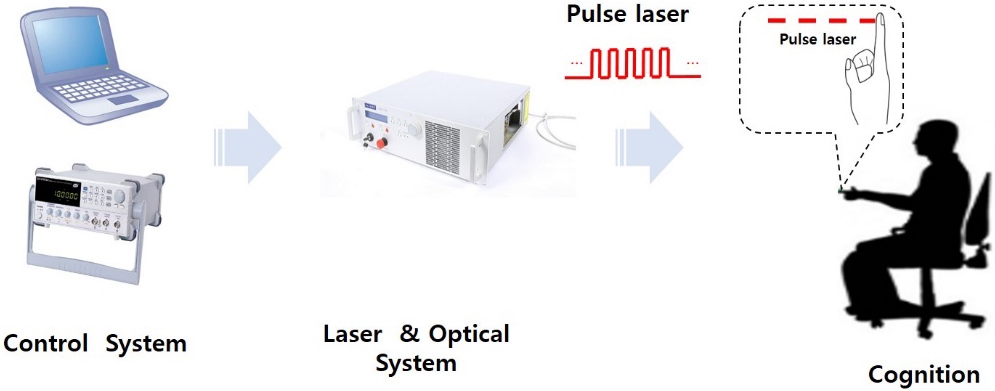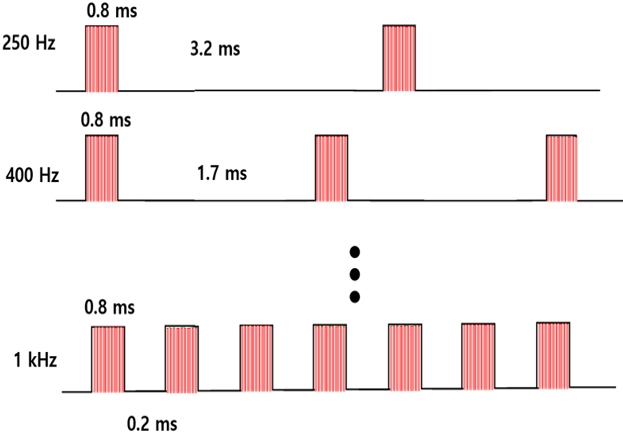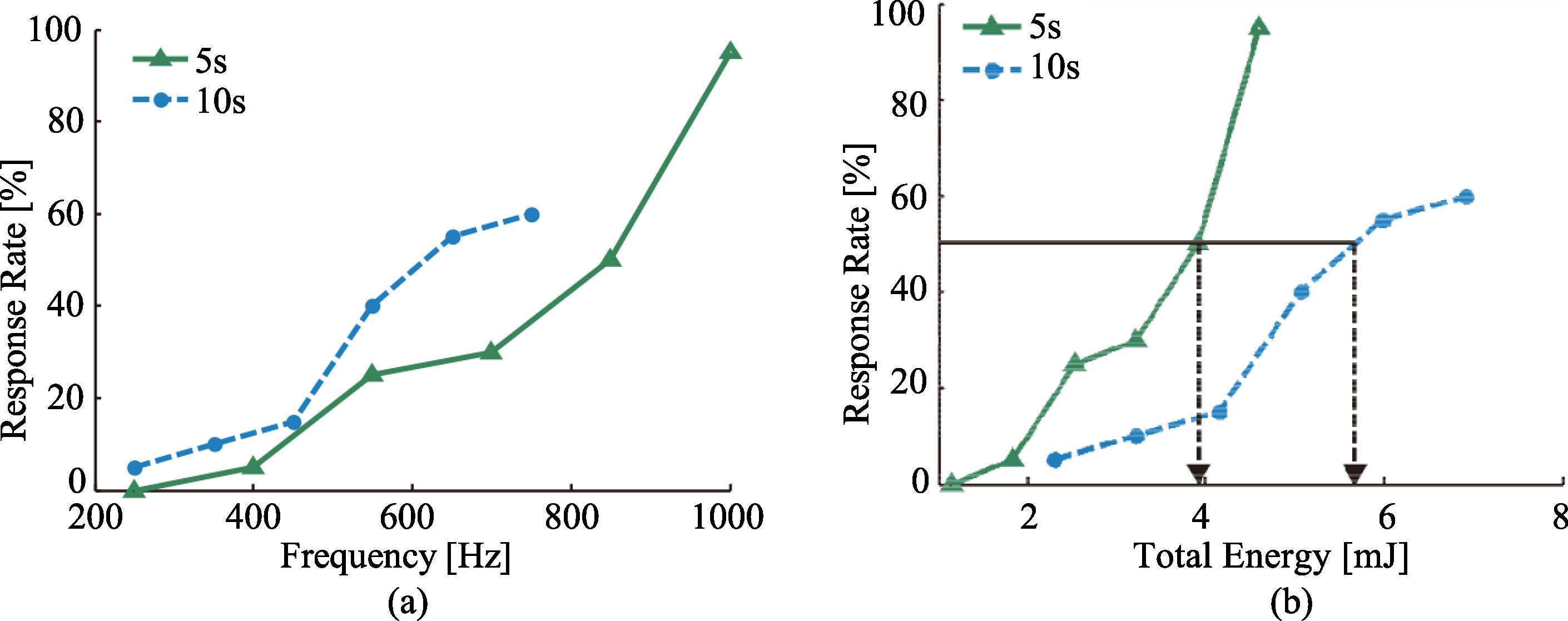Laser parameters for efficient biomedical stimulation: A study to increase cognitive response rate
Abstract
BACKGROUND:
The laser is able to irradiate the exact amount of stimulation to an area by a non contact method, and has the advantage of being able to stimulate the local target area.
OBJECTIVE:
This study examined an efficient method of laser tactile stimulation using laser parameter combinations.
METHODS:
The laser parameters that could cause an increase in the cognitive response rate of human subjects were examined without increasing the amount of total laser energy.
RESULTS:
As a result, the appropriate matching parameters such as duty ratio, pulse frequency, and exposure time of laser pulses showed a dominant influence in effectively increasing the tactile response rate of subjects with limited amount of total laser energy.
CONCLUSIONS:
This study can be applied to neurophysiology, cognitive research, and clinical laser application.
1.Introduction
Development of laser-related equipment is actively underway for diagnosis, treatment, and clinical research. In particular, laser-related research has been actively carried out to relieve or treat diseases using skin and nerve stimulation principles [1, 2, 3]. Recently, research on tactile stimulation using lasers has been attempted [4]. Laser tactile stimulation can be applied to cognitive science, which studies active brain areas using EEG, and neurophysiology, which studies the results of nociceptor stimulation [5, 6]. The laser can be easily applied anywhere on the target area of the skin, and the stimulation device does not directly touch it, so the risk of infection is low and there is an advantage that an accurate amount of stimulation can be exposed. Therefore, the need of clinical laser research in the application on tactile stimulation and cognitive research is increasing compared to chemical stimulation, mechanical stimulation and electrical stimulation [7, 8, 9, 10, 11]. Currently, tactile stimulation presentation methods have limitations in precisely controlling parameters such as the intensity of the stimulus, the presenting area and the duration time. For example, electrical stimulation is the most common stimulus to induce pain in animals and humans. However, there is a disadvantage that the size of the system is large, complex, and the intensity and the direction of the stimulus cannot be precisely adjusted. It can also be accompanied by an uncomfortable feeling when presented with the stimulus and when it passes through the skin to stimulate receptors and nerves, excessive stimulation can cause pain. There is an additional disadvantage that an electrode must be attached to the target tissue. Among the mechanical stimulation methods, vibration stimulation has a limitation in showing a small area of touch, and it is difficult to miniaturize the attachment device [12]. Although research on tactile stimulation using lasers capable of precise stimulation is being carried out, only a few studies have examined which parameter is better applied to tactile stimulation by combining various laser parameters in the field of cognitive research. Previously, some studies have been conducted on cognitive response with increasing stimulus intensity [13]. However, there are not many studies regarding efficient cognitive response based on various laser parameter combinations. This study investigated a method of increased stimulation with a small dosage by varying the combination of various laser parameters (pulse energy, frequency, duty ratio, and exposure time) In addition the method of increasing the intensity of the stimulus by increasing the dose of laser was also examined. In this research, a laser tactile stimulus study was carried out using a diode laser. The advantages are that parameters are easily changed while maintaining a stable laser output. The results of this study can be applied to clinical, neurophysiological, and cognitive research. In addition, it can be used valuably in stimulation for cell channel activation, low power laser therapy, optical transfection, etc.
Figure 1.
Schematic of laser stimulation procedure.

2.Materials and methods
2.1Laser stimulation procedure
Figure 1 is a schematic diagram of an experimental setup for laser tactile stimulation. The computer and the function generator were used to precisely control the laser parameters. The laser used in the experiment is a fiber coupled diode laser system (PearlTMTKS-B, nLight Photonics Corp., Santa Clara, CA, USA) with optical fibers connected. The wavelength of this laser is 809 nm and the pulse width range is variable to 10
Two experiments were conducted for the study of laser parameter combinations for tactile stimulation. First, the most effective laser parameters for increasing the response rate of tactile stimulation were studied by changing the energy, exposure time, and frequency after fixing the total energy. The second method was to study effective laser frequency and exposure time according to various combinations of laser parameters by fixing the energy per laser pulse without fixing the total energy.
Table 1
Laser parameters used in experiment 1
| Total energy | Frequency | |||||
|---|---|---|---|---|---|---|
| 0.5 Hz | 5 Hz | 50 Hz | 250 Hz | 500 Hz | ||
| Duty ratio 25% | Exposure time [s] | 20 | 20 | 20 | 20 | 19.8 |
| Energy per pulse [mJ] | 46.05 | 4.605 | 0.4605 | 0.0921 | 0.0465 | |
| Duty ratio 50% | Exposure time [s] | 10 | 10 | 10 | 10 | 10 |
| Energy per pulse [mJ] | 92.1 | 9.21 | 0.921 | 0.1842 | 0.0921 | |
| Duty ratio 75% | Exposure time [s] | 6.67 | 6.67 | 6.67 | 6.67 | 6.67 |
| Energy per pulse [mJ] | 138.15 | 13.815 | 1.3815 | 0.2763 | 0.13815 | |
Figure 2.
Stimulus presentation method with fixed total energy.

2.2Experiment 1: Laser stimulation with fixed total energy
Figure 2 shows the laser pulse stimulation method when the duty ratio is 25%. The total energy was fixed at 460.05 mJ, and then the pulse energy, frequency, and exposure time per pulse were changed. The gate timer mode of the diode laser was used for accurate stimulation presentation. In this mode, the exposure time could be precisely controlled by setting the laser pulse pause and pulse duration via the trigger signal connected with the laser. At this time, the peak power of the laser was fixed at 30.7 W and the energy per pulse was adjusted by changing the pulse width of the laser
Table 1 shows the experimental parameters used in Experiment 1. After fixing the total at 460.05 mJ, experimental parameters such as duty ratio, exposure time, energy per pulse and frequency were selected and combined for various laser parameter combinations. The duty ratios were set to 3 stages, 25%, 50% and 75%, and the frequency was set to 0.5 Hz, 5 Hz, 50 Hz, 250 Hz, and 500 Hz. At this time, the exposure time changes according to the laser pulse width variation and the duty ratio. The exposure time, frequency and the energy per pulse parameters were set based on previous experiments at a point where subjects have almost no pain but still feel contact.
Table 2
The laser parameters and total energy used for experiment 2
| Exposure time | Frequency | |||||
|---|---|---|---|---|---|---|
| 250 Hz | 400 Hz | 550 Hz | 700 Hz | 850 Hz | 1 kHz | |
| 5 s | 1.151 mJ | 1.842 mJ | 2.532 mJ | 3.2235 mJ | 3.9142 mJ | 4.605 mJ |
| 250 Hz | 350 Hz | 450 Hz | 550 Hz | 650 Hz | 750 Hz | |
| 10 s | 2.3025 mJ | 3.2235 mJ | 4.1445 mJ | 5.0655 mJ | 5.9865 mJ | 6.9075 mJ |
Table 3
Response rate of subjects with fixed total energy
| Duty ratio | 0.5 Hz | 5 Hz | 50 Hz | 250 Hz | 500 Hz |
|---|---|---|---|---|---|
| 25% | 53% | 29% | 35% | 6% | 29% |
| 50% | 59% | 41% | 41% | 47% | 35% |
| 75% | 76% | 59% | 76% | 76% | 76% |
Figure 3.
Stimulus presentation method with fixed pulse width.

2.3Experiment 2: Laser stimulation with fixed pulse width and energy per pulse
Figure 3 shows the laser stimulation method when energy per pulse is fixed. Experiments were conducted by changing the laser frequency and exposure time after setting the pulse width of laser energy to 0.8 ms. At this time, the total energy according to the stimulus was not fixed. Again, the gate timer mode of the diode laser was used for accurate stimulus presentation and the subjects were asked about the perceived feeling after the end of the stimulation to organize the data.
Table 2 shows the experimental parameters used in Experiment 2. After fixing the laser energy per pulse at 0.7368 mJ, the laser energy exposure time and frequency were combined to obtain cognitive response results. Although the energy per pulse was fixed, it showed that the total energy is changed by the change of frequency and exposure time. For various laser parameter combinations, the frequency was set to 250 Hz–1 kHz and the exposure time was set to 5 s or 10 s. As in Experiment 1, the exposure time, frequency, and energy per pulse were again set to be the most effective experimental range for the cognitive response through previous experiments.
Figure 4.
Cognitive response rate according to laser parameter change with fixed total energy.

3.Results and discussion
3.1Effect of duty ratio on human response
Table 3 shows the cognitive response rate according to the laser parameter change when the total energy is 460.05 mJ. The response rate in the table is the ratio of the subjects feeling sensation, and the parameters with response rates of 50% or more is shaded. In the fixed total energy condition, the cognitive response rate was the highest when the frequency was low under the same duty ratio condition. For example, when the duty ratio was 25%, the response rate was 53% at 0.5 Hz and 29% at 500 Hz. This suggests when the duty ratio is fixed, if the frequency is low, the energy per pulse is high. When the duty ratio is 25%, the energy per pulse is 46.05 mJ at a frequency of 0.5 Hz and 0.0465 mJ at 500 Hz. That is, when the same total energy of 460.05 mJ is irradiated to the human body, the energy per pulse is about 1000 times different according to the duty ratio. This suggests that the cognitive response rate has increased because of it. As a result, even if the same amount of total energy is irradiated, it is possible to obtain a more effective cognitive response rate of the subjects by increasing energy per pulse and decreasing frequency.
Figure 4 shows the trend of cognitive response rate according to changes of frequency and duty ratio. With a frequency of 0.5 Hz, the response rate was 53% when the duty ratio was 25%, 59% when the duty ratio was 50%, and 76% when the duty ratio was 75%. This trend was similar in all frequency ranges and the details are illustrated in Figure 4. In addition, under the condition that the total energy was constant, the result of the cognitive response rate according to the frequency change did not show a certain tendency. In other words, it is considered that an effective way to increase the response rate is to increase duty ratio rather than the frequency.
Figure 5.
Cognitive response rate with laser parameter changes. (a) Change in response rate with increasing frequency, (b) Change in response rate with increasing total energy.

3.2Influence of frequency change and exposure time change
Figure 5 is a graph showing the response rate of the subject perceiving the tactile sensation being exposed to laser stimulation by changing the frequency and exposure time with a fixed pulse width. Figure 5a shows the response rate with increasing frequency. The response rate was 25% at 550 Hz with an exposure time of 5 s and 95% at 1 kHz. This figure shows that as the frequency increased, the response rate increased. Even when the exposure time was 10 s, the response rate tended to increase as the frequency increased. This is because, unlike the prior condition with fixed total energy, it is considered that the cognitive response rate is more affected by the frequency when the total energy is not fixed.
Figure 5b is a graph showing the response rate of the subjects with total energy increase. Comparing the total energy of the laser exposure time of 5 s and 10 s at the response rate of 50%, the total energy is about 3.914 mJ when the exposure time is 5 s and 5.507 mJ when it is 10 s. It can be seen that the efficiency is better at 5 s where less energy is used showing the same response rate. This indicates that an increase in cognitive response rate can be achieved with small total energy. That is, using a proper combination of exposure time and frequency can induce a higher cognitive response rate with a small amount of total energy.
4.Conclusion
This goal of this study was to find the most efficient condition to obtain a tactile response by changing various parameters of a laser. As a result of the experiment it was found that : 1) The higher the duty ratio, the higher the duty response rate than the frequency and exposure time under the same total energy condition, 2) The higher the frequency, the higher the tactile response rate under the same energy per pulse condition. As a main result of the research, it was confirmed that not only the increased exposure amount of the laser but also the proper combination of the frequency and the duty ratio was more effective in increasing the response rate of the subject. The tactile response rate could be increased with a small amount of energy and it was found that biomedical laser stimulation could be achieved effectively though appropriate combination of various laser parameters (duty ratio, frequency, and exposure time). In order to obtain a higher response rate result, a more diverse set of laser parameter combinations is needed in the future and this paper is expected to be applicable to neurophysiology, cognitive research, and clinical research.
Acknowledgments
This research was supported by Basic Science Research Program through the National Research Foundation of Korea (NRF) funded by the Ministry of Education (No. 2016R1D1A3B03930427) and Basic Science Research Program through the National Research Foundation of Korea (NRF) funded by the Ministry of Education (No. 2016R1A6A3A11930264).
Conflict of interest
None to report.
References
[1] | Hunter J, et al. Effects of low energy laser on wound healing in a porcine model. Lasers in Surgery and Medicine (1984) ; 3: (4): 285-290. |
[2] | Martins F, et al. Low-level laser therapy modulates musculoskeletal loss in a skin burn model in rats. Acta Cirurgica Brasileira (2015) ; 30: (2): 94-99. |
[3] | Nussbaum EL, et al. Effects of low intensity laser irradiation during healing of infected skin wounds in the rat. Photonics and Lasers in Medicine (2014) ; 3: (1): 23-36. |
[4] | Jun J-H, et al. Laser-induced thermoelastic effects can evoke tactile sensations. Scientific Reports (2015) ; 5: : 11016. |
[5] | Bingel U, et al. Single trial fMRI reveals significant contralateral bias in responses to laser pain within thalamus and somatosensory cortices. Neuroimage (2003) ; 18: (3): 740-748. |
[6] | Mouraux A, Iannetti GD. Nociceptive laser-evoked brain potentials do not reflect nociceptive-specific neural activity. Journal of Neurophysiology (2009) ; 101: (6): 3258-3269. |
[7] | Avci P, et al. Low-level laser (light) therapy (LLLT) in skin: Stimulating, healing, restoring. Seminars in Cutaneous Medicine And Surgery. Frontline Medical Communications (2013) ; 41-52. |
[8] | De Tommaso M, et al. Update on laser-evoked potential findings in fibromyalgia patients in light of clinical and skin biopsy features. Journal of Neurology (2014) ; 261: (3): 461-472. |
[9] | Esmaeelinejad M, et al. The effects of low-level laser irradiation on cellular viability and proliferation of human skin fibroblasts cultured in high glucose mediums. Lasers in Medical Science (2014) ; 29: (1): 121-129. |
[10] | Rossi P, et al. Sympathetic skin response evoked by laser skin stimulation. Functional Neurology (2002) ; 17: (3): 129-132. |
[11] | Plaghki L, Mouraux A. How do we selectively activate skin nociceptors with a high power infrared laser? Physiology and biophysics of laser stimulation. Neurophysiologie Clinique/Clinical Neurophysiology (2003) ; 33: (6): 269-277. |
[12] | Moshourab R, et al. Measurement of vibration detection threshold and tactile spatial acuity in human subjects. Journal of Visualized Experiments: JoVE (2016) ; 115. |
[13] | Kim J-S, et al. Study of somesthesis according to change in pulse diode laser parameters. Bio-Medical Materials and Engineering (2015) ; 26: (s1): S1001-S1008. |




